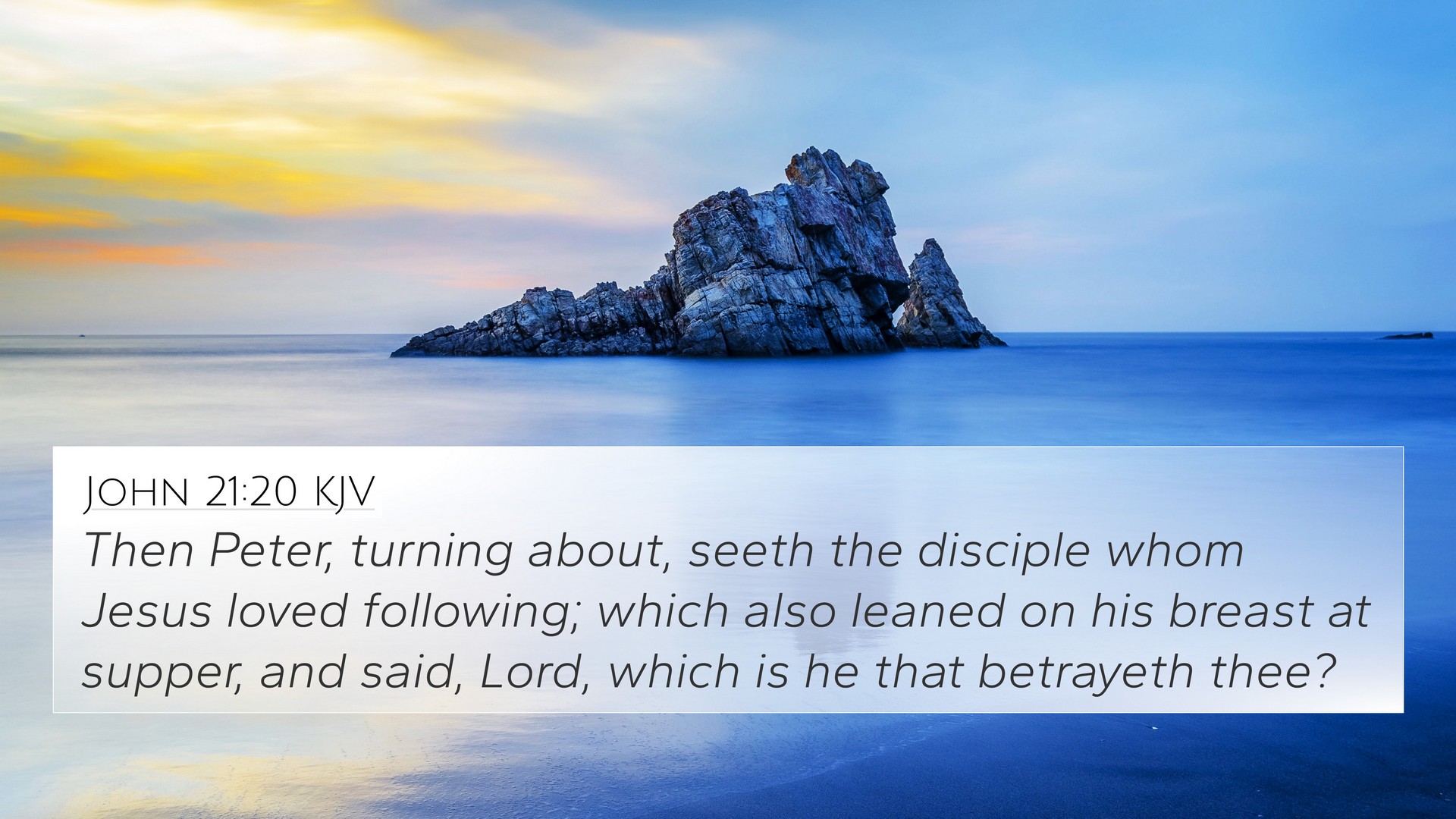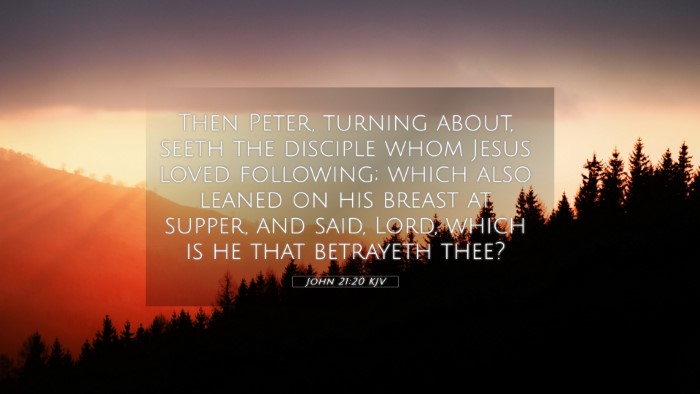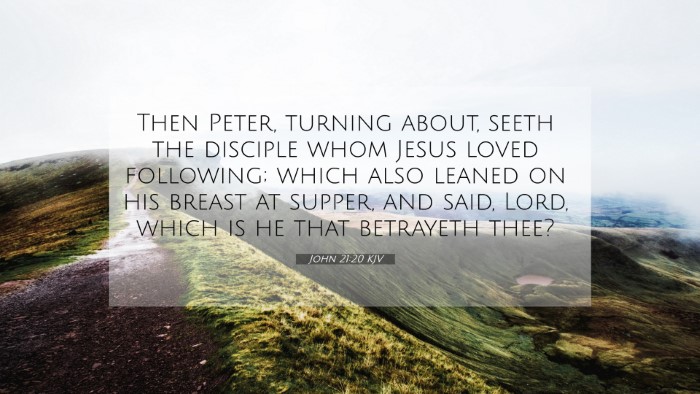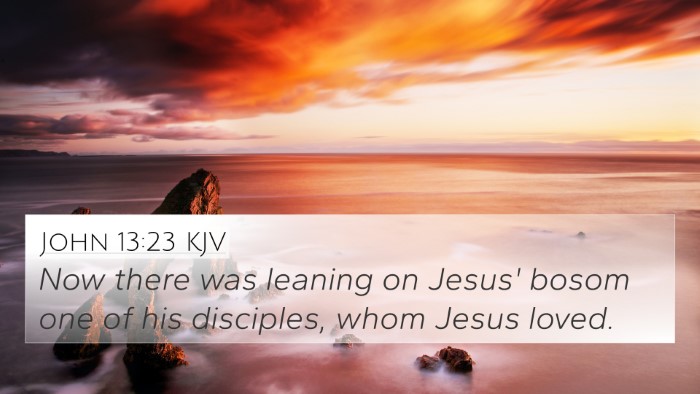Old Testament
Genesis Exodus Leviticus Numbers Deuteronomy Joshua Judges Ruth 1 Samuel 2 Samuel 1 Kings 2 Kings 1 Chronicles 2 Chronicles Ezra Nehemiah Esther Job Psalms Proverbs Ecclesiastes Song of Solomon Isaiah Jeremiah Lamentations Ezekiel Daniel Hosea Joel Amos Obadiah Jonah Micah Nahum Habakkuk Zephaniah Haggai Zechariah MalachiJohn 21:20 Similar Verses
John 21:20 Cross References
Then Peter, turning about, seeth the disciple whom Jesus loved following; which also leaned on his breast at supper, and said, Lord, which is he that betrayeth thee?
Uncover the Rich Themes and Topics of This Bible Verse
Listed below are the Bible themes associated with John 21:20. We invite you to explore each theme to gain deeper insights into the Scriptures.
John 21:20 Cross Reference Verses
This section features a detailed cross-reference designed to enrich your understanding of the Scriptures. Below, you will find carefully selected verses that echo the themes and teachings related to John 21:20 KJV. Click on any image to explore detailed analyses of related Bible verses and uncover deeper theological insights.
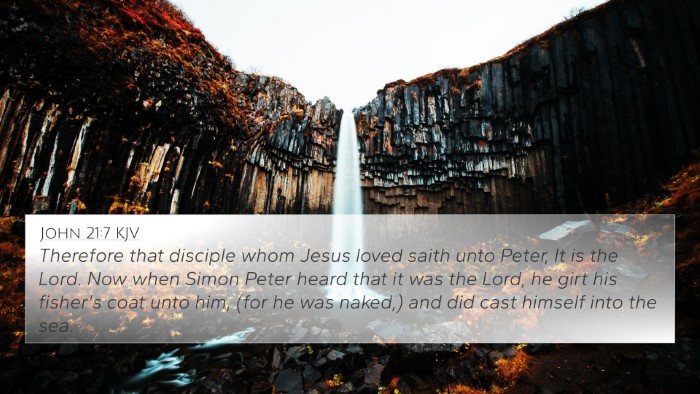
John 21:7 (KJV) »
Therefore that disciple whom Jesus loved saith unto Peter, It is the Lord. Now when Simon Peter heard that it was the Lord, he girt his fisher's coat unto him, (for he was naked,) and did cast himself into the sea.

John 20:2 (KJV) »
Then she runneth, and cometh to Simon Peter, and to the other disciple, whom Jesus loved, and saith unto them, They have taken away the LORD out of the sepulchre, and we know not where they have laid him.
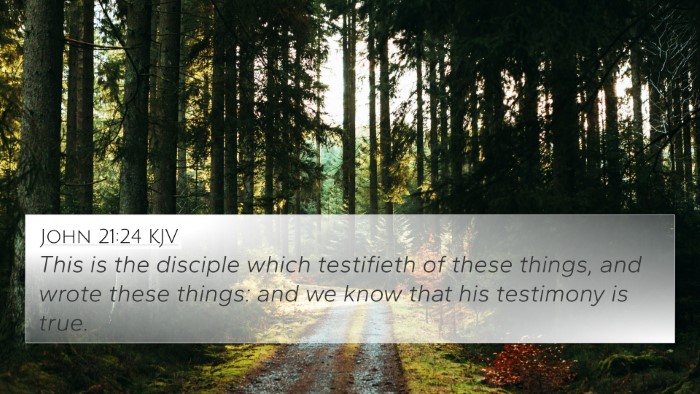
John 21:24 (KJV) »
This is the disciple which testifieth of these things, and wrote these things: and we know that his testimony is true.
John 21:20 Verse Analysis and Similar Verses
Understanding John 21:20
In John 21:20, we find a significant dialogue involving the Apostle Peter. The verse states:
"Then Peter, turning around, saw the disciple whom Jesus loved following, who also had leaned on His breast at the supper, and said, 'Lord, who is the one who betrays You?'"
This verse presents a moment of reflection and inquiry from Peter, revealing deeper themes of discipleship, relationship, and prophetic insight that resonate throughout the biblical narrative.
Commentary Insights
Insights from notable public domain commentaries provide a richer understanding of this verse.
-
Matthew Henry:
Matthew Henry emphasizes the relational aspect of the disciples' dynamics and the importance of friendship and loyalty. He discusses the disciple whom Jesus loved, often considered John, and how this connection illustrates faithfulness in following Christ. It highlights Peter's curiosity not about himself but about John, demonstrating human nature's tendency to look beyond oneself in moments of uncertainty.
-
Albert Barnes:
Albert Barnes explores the symbolism behind Peter's inquiry and the significance of the disciple who is leaning on Jesus. He remarks on the closeness of that relationship, showing how the beloved disciple represents genuine love and trust in Jesus, contrasting with Peter's often impetuous nature. This contrast serves to enrich our understanding of the qualities ideal in following Jesus.
-
Adam Clarke:
Adam Clarke draws attention to the prophetic understanding of discipleship's journey and the responsibilities that come with it. He notes that Peter's question reflects a typical human concern about others—instead of focusing solely on his own calling. Clarke suggests this introduces the theme of interdependence among believers in the community of faith.
Thematic Connections and Cross-References
John 21:20 resonates with various themes throughout the Bible, which can be connected through a comparative verse analysis. Here are some significant cross-references:
- John 13:23: This verse identifies the disciple whom Jesus loved, enhancing the relationship context in John 21:20.
- Matthew 16:16: Peter's confession of Christ's identity paves the way for understanding his role and significance within the discipleship circle.
- 1 John 1:1: The essence of relationship with Christ is further explored, with echoes of fellowship and closeness.
- Luke 22:31-32: Jesus forewarns Peter of his trials, adding depth to Peter's concern for others, including the beloved disciple.
- 1 Corinthians 3:5-9: The concept of being fellow workers in God's field highlights the communal responsibility among believers.
- Philippians 1:3-5: Paul discusses his partnership in the Gospel, mirroring the relationships depicted in John's account.
- Hebrews 10:24-25: The importance of encouraging one another is foundational in understanding the dynamic among believers.
- James 5:16: Confession and prayer illustrate the interconnectedness of the faith community, resonating with Peter's inquiries.
- Revelation 1:9: The shared suffering among the disciples connects to the anticipated trials ahead, reflecting Peter's concern.
- Acts 15:36-41: The decisions made within the community of believers further exemplify interpersonal dynamics in ministry work.
Inter-Biblical Dialogue and Thematic Links
In exploring the connections between Bible verses, we see how John 21:20 encapsulates elements of discipleship, community, and prophetic fulfillment. The cross-referring Biblical texts not only link the Gospels but also reflect the wider narrative themes found in Old and New Testament writings.
This verse serves as a poignant reminder of the roles and relationships among Jesus' followers, and how their interconnected lives embody the teachings and love of Christ. The cross-referencing Bible study methods can further uncover profound insights into how these verses relate to one another.
Tools for Bible Cross-Referencing
Studying Bible verse connections efficiently often requires the right tools. Utilizing a Bible concordance and cross-reference Bible study materials can enhance your understanding. Here are some methods for effectively employing cross-references:
- Utilizing index systems to find related verses.
- Employing software or apps that provide comprehensive cross-reference guides.
- Studying thematic Bible verse connections through topical Bibles.
- Engaging in group studies to discuss and identify connecting scriptures.
Conclusion
John 21:20 serves as a reminder of the intricate relationships that bind the community of believers, the significance of following Jesus, and the nature of inquiry that opens dialogues about faith. By cross-referencing this verse with others, one expands the understanding of biblical themes and contextualizes one's personal faith journey.
As we delve deeper into the Bible cross-reference system, we can discover richer meanings and learn how to interpret biblical themes across various contexts, enhancing our spiritual lives.
